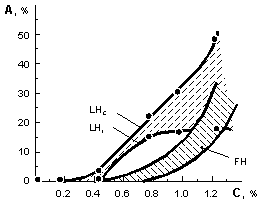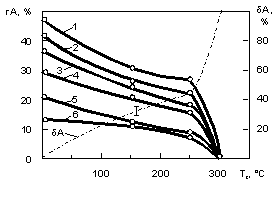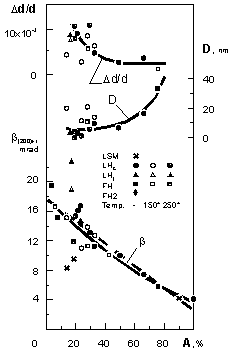 Fig.1. Effect of carbon on the retained austenite content in steel after laser hardening (LHc - complete, LHi - incomplete laser hardening) [3]; FH - after conventional furnace hardening, literature generalised data. Fig.1. Effect of carbon on the retained austenite content in steel after laser hardening (LHc - complete, LHi - incomplete laser hardening) [3]; FH - after conventional furnace hardening, literature generalised data. |  Fig.2. Breakdown of retained austenite at various tempering temperatures (for 2 h). A - content retained austenite in steel; δA - relative amount of brokendown retained austenite: δA = (Ai − A) ⁄ Ai×100%, where Ai - initial content of retained austenite, %. 1 and 3 - 1.2%C, 4 - 1.0%C, 5 - 0.8%C steels, 2 and 6 - 1.0%C-1.5%Cr steel; 3 and 6 - after furnace quenching, the rest - after LHT, 7 - relative amount of brokendown retained austenite (δA) Fig.2. Breakdown of retained austenite at various tempering temperatures (for 2 h). A - content retained austenite in steel; δA - relative amount of brokendown retained austenite: δA = (Ai − A) ⁄ Ai×100%, where Ai - initial content of retained austenite, %. 1 and 3 - 1.2%C, 4 - 1.0%C, 5 - 0.8%C steels, 2 and 6 - 1.0%C-1.5%Cr steel; 3 and 6 - after furnace quenching, the rest - after LHT, 7 - relative amount of brokendown retained austenite (δA) |  Fig.3. Dependence of the structural broadening of lines (200)γ, the size of mosaic blocks and microdistortions of the crystal lattice of retained austenite on its content in steel (the solid line - triple term approximation, dotted one - linear approximation). Symbols in the graph: LSM - laser surface melting; LHc - complete and LHi - incomplete laser hardening; FH - furnace hardening; FH2 - double furnace hardening; Temp. - tempering temperature [5]. Fig.3. Dependence of the structural broadening of lines (200)γ, the size of mosaic blocks and microdistortions of the crystal lattice of retained austenite on its content in steel (the solid line - triple term approximation, dotted one - linear approximation). Symbols in the graph: LSM - laser surface melting; LHc - complete and LHi - incomplete laser hardening; FH - furnace hardening; FH2 - double furnace hardening; Temp. - tempering temperature [5]. |
 Fig.1. Effect of carbon on the retained austenite content in steel after laser hardening (LHc - complete, LHi - incomplete laser hardening) [3]; FH - after conventional furnace hardening, literature generalised data.
Fig.1. Effect of carbon on the retained austenite content in steel after laser hardening (LHc - complete, LHi - incomplete laser hardening) [3]; FH - after conventional furnace hardening, literature generalised data. Fig.2. Breakdown of retained austenite at various tempering temperatures (for 2 h). A - content retained austenite in steel; δA - relative amount of brokendown retained austenite: δA = (Ai − A) ⁄ Ai×100%, where Ai - initial content of retained austenite, %. 1 and 3 - 1.2%C, 4 - 1.0%C, 5 - 0.8%C steels, 2 and 6 - 1.0%C-1.5%Cr steel; 3 and 6 - after furnace quenching, the rest - after LHT, 7 - relative amount of brokendown retained austenite (δA)
Fig.2. Breakdown of retained austenite at various tempering temperatures (for 2 h). A - content retained austenite in steel; δA - relative amount of brokendown retained austenite: δA = (Ai − A) ⁄ Ai×100%, where Ai - initial content of retained austenite, %. 1 and 3 - 1.2%C, 4 - 1.0%C, 5 - 0.8%C steels, 2 and 6 - 1.0%C-1.5%Cr steel; 3 and 6 - after furnace quenching, the rest - after LHT, 7 - relative amount of brokendown retained austenite (δA) Fig.3. Dependence of the structural broadening of lines (200)γ, the size of mosaic blocks and microdistortions of the crystal lattice of retained austenite on its content in steel (the solid line - triple term approximation, dotted one - linear approximation). Symbols in the graph: LSM - laser surface melting; LHc - complete and LHi - incomplete laser hardening; FH - furnace hardening; FH2 - double furnace hardening; Temp. - tempering temperature [5].
Fig.3. Dependence of the structural broadening of lines (200)γ, the size of mosaic blocks and microdistortions of the crystal lattice of retained austenite on its content in steel (the solid line - triple term approximation, dotted one - linear approximation). Symbols in the graph: LSM - laser surface melting; LHc - complete and LHi - incomplete laser hardening; FH - furnace hardening; FH2 - double furnace hardening; Temp. - tempering temperature [5].